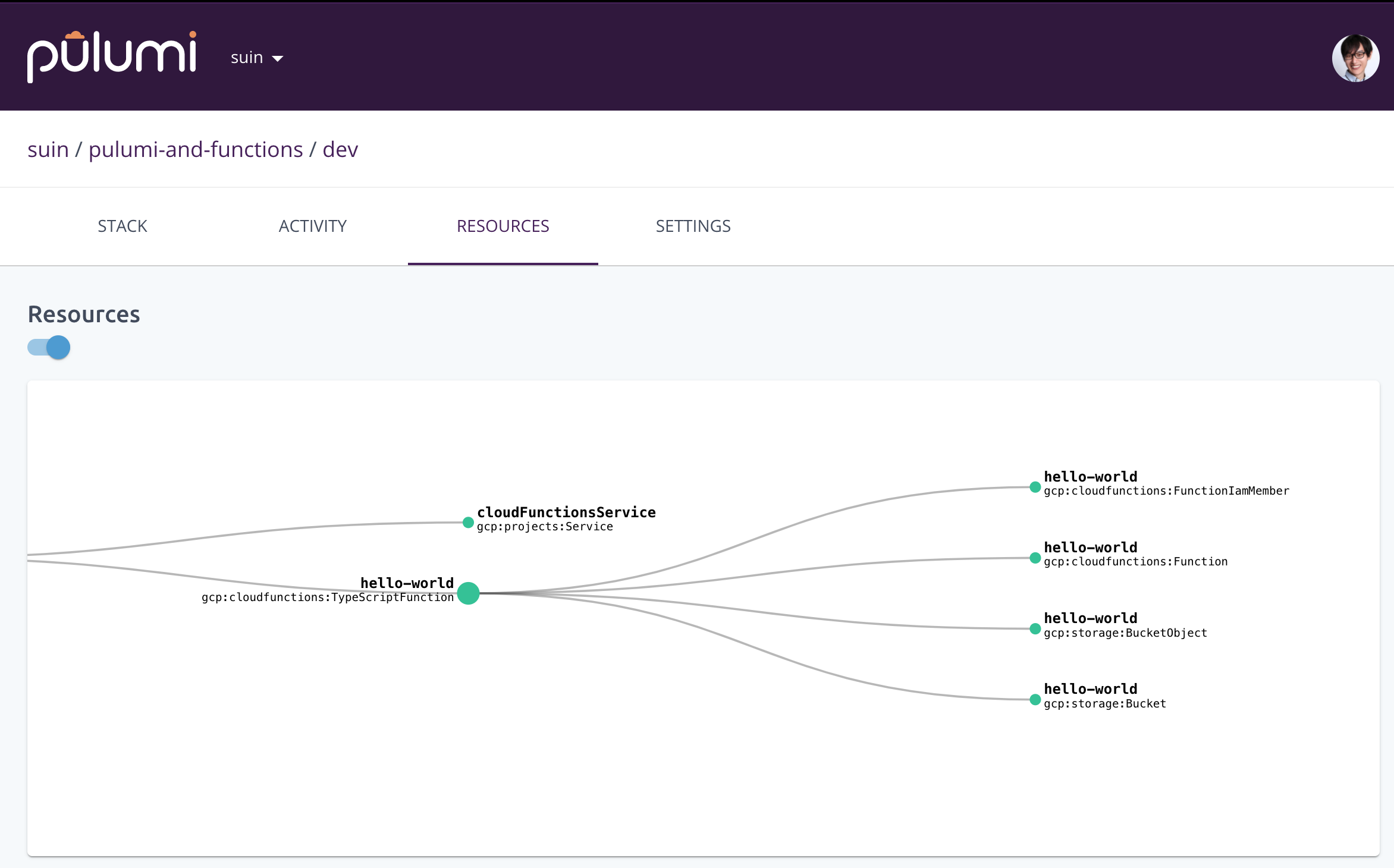前回の投稿で、PulumiでデプロイされるTypeScript製Cloud FunctionsをES2019にする小技について書きました。そこで示したPulumiのスクリプトは、Google Cloud PlatformのStorage、Cloud Functionsの2つのスタックにまたがり、4つのリソースを組み合わせて構成するインフラでした。
この投稿では、こうした複数のスタックや複数のリソースにまたがる設定を「コンポーネント」という形でとりまとめ、その設定を再利用できるようにする方法を紹介します。
取りまとめる前のPulumiスクリプト
まず、複数のスタックにまたがるPulumiスクリプトがどんなものか見ておきます。ちょっと長くなりますが、次のような感じです。
import * as pulumi from "@pulumi/pulumi";
import * as gcp from "@pulumi/gcp";
import packlist from "npm-packlist";
// Cloud Functions APIを有効化する
const cloudFunctionsService = new gcp.projects.Service(
"cloudFunctionsService",
{
disableDependentServices: true,
service: "cloudfunctions.googleapis.com",
}
);
// helloWorldパッケージのZIPの内容を定義する
const assetArchive = new pulumi.asset.AssetArchive(
packlist({ path: "./helloWorld" }).then((files) => {
const map: pulumi.asset.AssetMap = {};
for (const file of files) {
map["./" + file] = new pulumi.asset.FileAsset("./helloWorld/" + file);
}
return map;
})
);
// Cloud Functionsの関数のZIP置き場をStorageに作る
const cloudfunctionsBucket = new gcp.storage.Bucket("cloudfunctions");
// helloWorldパッケージのZIPをStorageにアップロードする
const helloWorldZip = new gcp.storage.BucketObject("helloWorld", {
bucket: cloudfunctionsBucket.name,
name: "helloWorld.zip",
source: assetArchive,
});
// デプロイする関数のインフラ構成定義
const helloWorldFunction = new gcp.cloudfunctions.Function(
"helloWorldFunction",
{
name: "helloWorld",
runtime: "nodejs12",
sourceArchiveBucket: cloudfunctionsBucket.name,
sourceArchiveObject: helloWorldZip.name,
triggerHttp: true,
entryPoint: "helloWorld",
},
{ dependsOn: cloudFunctionsService }
);
// helloWorld関数を誰でも呼び出せるようにする設定
const helloWorldInvoker = new gcp.cloudfunctions.FunctionIamMember(
"helloWorldInvoker",
{
cloudFunction: helloWorldFunction.name,
role: "roles/cloudfunctions.invoker",
member: "allUsers",
}
);
// デプロイ後に表示する情報
export const functionUrl = helloWorldFunction.httpsTriggerUrl;
各部分の細かい説明は、前回の投稿に書いてあるので割愛しますが、やりたいことは「ひとつのTypeScript製の関数をCloud Functionsにデプロイしたい」というものです。
なので、もう一つ別にTypeScriptの関数をデプロイしようとなると、これと同じコードを量産しないといけなくなります。さすがに、それは辛いので避けたいものです。
複数のスタックにまたがる設定をまとめて再利用可能にする「コンポーネント」
Pulumiには、コンポーネントという概念があります。これは、複数のスタックにまたがる設定をまとめ上げ、再利用可能にするものです。
ここからは、Pulumiコンポーネントの作り方を、上のコードを改修しながら説明していきます。
まず、コンポーネントを作るために、コンポーネントを書き込むファイルをひとつ作ります。上の例では、「TypeScriptの関数をCloud Functionsに配置する」が目的なので、そこから重要キーワードを抜粋して「TypescriptFunction」コンポーネントと名付けることにします。なので、作るファイルもそれに合わせて、typescriptFunction.tsにします。
次に、pulumi.ComponentResourceを継承したクラスをそこに定義します:
export class TypeScriptFunction extends pulumi.ComponentResource {
constructor(
name: string,
args?: TypeScriptFunctionArgs,
opts?: pulumi.ComponentResourceOptions
) {
super("gcp:cloudfunctions:TypeScriptFunction", name, {}, opts);
}
}
export type TypeScriptFunctionArgs = {}
このTypeScriptFunctionがコンポーネントになるわけですが、コンポーネントクラスのコンストラクタは、親クラスのコンストラクタを呼び出すようにする必要があります。親クラスのコンストラクタの第一引数が、コンポーネントの名前になります。名前はグローバルでかぶらない名前にする必要があります。プロジェクトローカルで再利用するコンポーネントであれば、projectName:components:ComponentNameのようにするのがいいと思います。今回作るコンポーネントはプロジェクトを超えて再利用したいので、"gcp:cloudfunctions:TypeScriptFunction"といったプロジェクト固有でない感じの名前にしました。
コンポーネントクラスでまとめるスタックやリソースの定義は、コンストラクタの続きに書いていきます。移行元のコードがあるなら、ほぼコピペするだけでできます。完成するとこんな感じになります:
import * as pulumi from "@pulumi/pulumi";
import * as gcp from "@pulumi/gcp";
import packlist from "npm-packlist";
export class TypeScriptFunction extends pulumi.ComponentResource {
readonly bucket: gcp.storage.Bucket;
readonly bucketObject: gcp.storage.BucketObject;
readonly function: gcp.cloudfunctions.Function;
readonly invoker: gcp.cloudfunctions.FunctionIamMember;
constructor(
name: string,
{
path,
bucket: bucketArgs,
bucketObject: bucketObjectArgs,
function: functionArgs,
invoker,
}: TypeScriptFunctionArgs,
opts?: pulumi.ComponentResourceOptions
) {
super("gcp:cloudfunctions:TypeScriptFunction", name, {}, opts);
// Cloud Functionsの関数のZIP置き場をStorageに作る
this.bucket = new gcp.storage.Bucket(name, bucketArgs, { parent: this });
// パッケージのZIPの内容を定義する
const asset = new pulumi.asset.AssetArchive(
packlist({ path }).then((files) => {
const map: pulumi.asset.AssetMap = {};
for (const file of files) {
map["./" + file] = new pulumi.asset.FileAsset(path + "/" + file);
}
return map;
})
);
// パッケージのZIPをStorageにアップロードする
this.bucketObject = new gcp.storage.BucketObject(
name,
{
...bucketObjectArgs,
bucket: this.bucket.name,
source: asset,
},
{ parent: this }
);
// デプロイする関数のインフラ構成定義
this.function = new gcp.cloudfunctions.Function(
name,
{
...functionArgs,
sourceArchiveBucket: this.bucket.name,
sourceArchiveObject: this.bucketObject.name,
},
{ parent: this }
);
// 特に指定がなければ、関数を誰でも呼び出せるようにする設定
this.invoker =
invoker ??
new gcp.cloudfunctions.FunctionIamMember(
name,
{
cloudFunction: this.function.name,
role: "roles/cloudfunctions.invoker",
member: "allUsers",
},
{ parent: this }
);
}
}
export type TypeScriptFunctionArgs = {
readonly path: string;
readonly bucket?: gcp.storage.BucketArgs;
readonly bucketObject?: Omit<
gcp.storage.BucketObjectArgs,
"bucket" | "source"
>;
readonly function: Omit<
gcp.cloudfunctions.FunctionArgs,
"sourceArchiveBucket" | "sourceArchiveObject" | "sourceRepository"
>;
readonly invoker?: gcp.cloudfunctions.FunctionIamMember;
};
移行元のコードと異なる点は、次のとおりです。
- リソース名が変数になる。
helloWorldなど、元コードではハードコーディングされていたリソース名が変数になります。これは当然そうなるのが分かると思います。 -
{ parent: this }の追加。これは、各リソース親がTypeScriptFunctionコンポーネントであることをPulumiに教えるためのものです。これを指定しなくても動きますが、指定することで、pulumi up時のプレビューや、Pulumiのダッシュボードでツリーで表示されるようになるので分かりやすくなります。
pulumi up時のプレビュー↓

Pulumiダッシュボード↓

- 各リソースの設定が変数になる。共通化する必要のない設定は変数にして、コンポーネントクラスのコンストラクタで受け取るようにします。
- 各リソースはコンポーネントオブジェクトのプロパティにする。こうしておくことで、
TypeScriptFunctionを利用するコードから各リソースの情報を参照できるようになります。
コンポーネントを利用する
コンポーネントは他のPulumiのAPIと同じように使います。
import * as gcp from "@pulumi/gcp";
import { TypeScriptFunction } from "./typescriptFunction";
// Cloud Functions APIを有効化する
const cloudFunctionsService = new gcp.projects.Service(
"cloudFunctionsService",
{
disableDependentServices: true,
service: "cloudfunctions.googleapis.com",
}
);
// 作ったコンポーネントを使う
const helloWorldFunction = new TypeScriptFunction(
"hello-world",
{
path: "./helloWorld",
function: {
runtime: "nodejs12",
triggerHttp: true,
entryPoint: "helloWorld",
},
},
{ dependsOn: cloudFunctionsService }
);
// デプロイ後に表示する情報
export const functionUrl = helloWorldFunction.function.httpsTriggerUrl;
コンポーネント化する前のコードと比べるとだいぶすっきりしました。もうひとつTypeScriptのCloud Functionを作りたい場合は、次の部分だけを増やしていけば良くなります:
const helloWorldFunction = new TypeScriptFunction(
"hello-world",
{
path: "./helloWorld",
function: {
runtime: "nodejs12",
triggerHttp: true,
entryPoint: "helloWorld",
},
},
{ dependsOn: cloudFunctionsService }
);
これで、同じようなコードをコピペして増やしていく必要も無くなります。